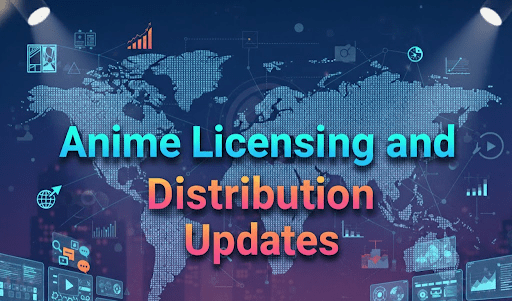Anime Licensing and Distribution Updates: Key Trends & Deals Shaping the Market

Introduction
The global anime market is experiencing a period of unprecedented expansion, transforming from a niche segment into a dominant force in the global entertainment landscape.
For executives in content acquisition, sales, and strategy, staying ahead of the rapid shifts in anime licensing and distribution updates is no longer just an advantage—it is a necessity.
Driven by the aggressive expansion of streaming platforms and a continuously growing international fanbase, the industry’s value is skyrocketing.
This dynamic environment presents both immense opportunities and significant challenges, demanding a strategic understanding of the latest trends, major content deals, and the evolving roles of key market players.
Key Takeaways
| Core Challenge | Keeping pace with the rapid consolidation of streaming rights, rising content acquisition costs, and new distribution models in the fast-moving global anime market. |
| Strategic Solution | Utilizing real-time market intelligence to monitor new project announcements, track competitor licensing deals, and identify emerging distribution partners and trends. |
| Vitrina’s Role | Vitrina provides a centralized intelligence platform for tracking the global anime supply chain, offering early warnings on projects and insights into the latest licensing and distribution deals. |
Market Growth & 2025 Projections: A Booming Industry
The financial scale of the anime industry is staggering, with multiple market analyses pointing toward sustained, robust growth.
According to a report from Grand View Research, the global anime market was valued at USD 34.25 billion in 2024 and is projected to grow at a compound annual growth rate (CAGR) of 9.8% from 2025 to 2030.
Another forecast from Research and Markets projects the market will grow from $28.55 billion in 2024 to $31.51 billion in 2025, demonstrating the sector’s incredible momentum.
This growth is not concentrated in its native Japan; it is a global phenomenon. North America has emerged as the fastest-growing market, with a forecasted CAGR of 16.3% through 2030.
This is fueled by the widespread accessibility of content through major streaming platforms and the deep cultural integration of anime into mainstream Western entertainment.
Merchandising remains a massive revenue driver, accounting for over 31% of the market share in 2024, but the most rapid expansion is seen in internet distribution, which is expected to grow at a CAGR of 13.8%.
These figures underscore a clear message for industry leaders: the demand for anime content and its associated intellectual property is accelerating globally, making every licensing and distribution decision more critical than ever.
The Streaming Wars’ Impact on Anime Licensing Updates
The intense competition among streaming services is a primary catalyst for the most significant anime licensing and distribution updates.
Giants like Netflix, Amazon Prime Video, and the Sony-owned powerhouse Crunchyroll are in an arms race to secure exclusive content, driving up acquisition costs and reshaping traditional distribution windows.
Crunchyroll, as a specialized platform, continues to dominate the dedicated anime streaming space. Following its acquisition by Sony and the absorption of Funimation, its library and global reach are unparalleled.
The platform’s strategy focuses heavily on simulcasts—releasing episodes globally just hours after they air in Japan—a model that caters directly to the most dedicated fans.
Meanwhile, Netflix has adopted a different but equally aggressive strategy, investing heavily in licensing high-profile exclusive series and funding “Netflix Originals” in partnership with Japanese studios.
This approach brings anime to a broader, more casual global audience that may not subscribe to a niche service. These competing strategies have created a seller’s market, where rights holders can command premium licensing fees.
For acquisition executives, this environment necessitates a sophisticated, data-driven approach to content valuation and negotiation to ensure a return on investment.
Key Trends Defining the Future of Anime Distribution
Beyond the streaming wars, several other trends are shaping the future of how anime is licensed and distributed. These updates reflect both technological advancements and shifting consumer behaviors that executives must monitor.
1. The Rise of Co-Productions
International media companies are increasingly moving beyond simple licensing and entering into co-production agreements with Japanese studios. This allows them to have a stake in the IP from the ground up, securing global distribution rights from inception.
This model offers more creative control and long-term financial upside, representing a deeper integration of global capital into the anime production pipeline.
2. AI and Technology in Localization
Artificial intelligence is beginning to accelerate the localization process. AI-powered tools for subtitling and even automated dubbing are reducing the time and cost required to prepare content for international markets.
While still maturing, this technology promises to shorten release windows further, enabling even faster global rollouts of new series and supporting the industry’s growth in emerging markets.
3. Franchise Expansion and Cross-Media Strategies
Successful anime is no longer confined to television screens. Rights holders are pursuing comprehensive cross-media strategies, expanding popular franchises into feature films, video games, live events, and extensive merchandising lines.
This 360-degree approach maximizes the value of an IP and creates multiple revenue streams. For distributors, securing rights may now involve complex negotiations that cover a wide range of ancillary products, requiring a holistic view of a franchise’s potential. Keeping track of the entire media supply chain is crucial for identifying these multi-faceted opportunities.
How Vitrina Navigates the Latest Anime Licensing Updates
In a market characterized by rapid change and fierce competition, having access to timely, accurate, and comprehensive data is critical. Vitrina is purpose-built to provide this strategic advantage.
The platform serves as a centralized intelligence hub for M&E professionals, tracking the entire global content supply chain, including the latest anime licensing and distribution updates.
For acquisition teams, Vitrina’s Project Tracker offers invaluable early warnings on new anime titles in every stage, from development to production. This allows buyers to identify and engage with rights holders long before a project hits the open market.
For distributors, the platform provides a global map of potential buyers, detailing their content needs and acquisition patterns. By providing verified contacts and deep company profiles, Vitrina removes the friction from the discovery and outreach process, enabling users to build the strategic relationships needed to close deals faster and more effectively.
Conclusion
The business of anime is in a golden age of global expansion, but this growth brings with it a new level of complexity.
The firehose of anime licensing and distribution updates, from nine-figure market forecasts to major platform-exclusive deals, requires constant vigilance.
Success in this environment is no longer just about having good taste; it is about making disciplined, data-informed decisions.
Executives who can effectively track market trends, anticipate competitor moves, and build a robust global network will be best positioned to capitalize on the enduring and ever-growing global demand for anime.
Frequently Asked Questions
The dominant trend in the anime market is its rapid globalization, driven by streaming platforms. This includes a surge in international co-productions, high-value exclusive licensing deals from services like Netflix and Crunchyroll, and the use of technology like AI to speed up localization for simultaneous global releases.
Yes, the anime industry is experiencing significant and sustained growth. Market forecasts project a strong compound annual growth rate (CAGR) of around 9-10% over the next several years, with the global market size expected to reach well over USD 60 billion by 2030, according to multiple industry reports.
The largest and most dominant distributor of anime globally is Crunchyroll. Owned by Sony, it has consolidated its position by merging with Funimation, and it boasts the most extensive library of licensed anime, specializing in simulcasting new series directly from Japan to a massive international subscriber base.
Licensing costs vary dramatically based on a title’s popularity, the exclusivity of the rights, and the territories included. A niche or library title might cost a few thousand dollars per episode, while a highly anticipated, exclusive simulcast license for a top-tier series can cost major platforms anywhere from $100,000 to over $500,000 per season.















































